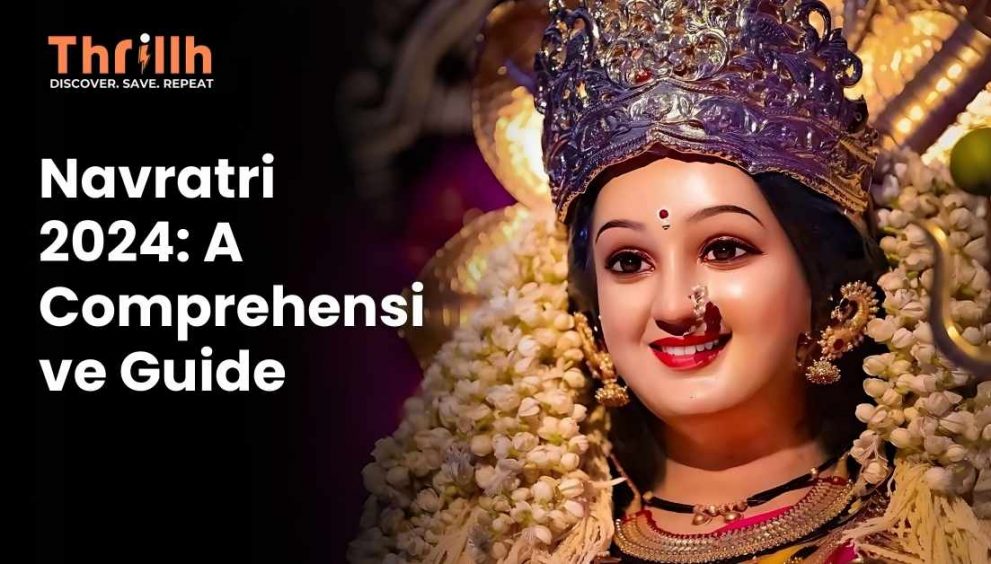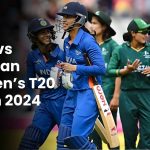Navratri is one of the most auspicious festivals in India, celebrated over nine nights and dedicated to the worship of the Hindu goddess Durga. The word “Navratri” translates to “nine nights” in Sanskrit, and each of these nights honors a different form of Goddess Durga. The festival symbolizes the victory of good over evil and is celebrated with fasting, prayers, cultural dances, and community gatherings. In 2024, Navratri will be celebrated from October 3rd to October 11th.
What is Navratri?
Navratri is a vibrant and spiritually significant Hindu festival celebrated in honor of Goddess Durga and her nine divine manifestations. According to Hindu mythology, the festival commemorates the victory of Goddess Durga over the buffalo demon Mahishasura, symbolizing the triumph of good over evil.
The Story Behind Navratri
The central story behind Navratri is rooted in the fierce battle between Goddess Durga and the demon Mahishasura. After a prolonged war that lasted for nine nights, Durga finally defeated Mahishasura on the tenth day, known as Vijayadashami or Dussehra. This victory represents the power of divine forces against the darkness of ignorance and evil.
Spiritual and Cultural Significance
Navratri is not only a religious observance but also a time for introspection and spiritual awakening. Each day of the festival is dedicated to one of the nine forms of Goddess Durga, and the rituals vary slightly across different regions. Apart from worship, Navratri is marked by vibrant cultural activities such as Garba and Dandiya dances, which bring communities together in joy and celebration.
Navratri 2024 Dates and Calendar
In 2024, Navratri will be celebrated from October 3rd to October 11th. The festival is divided into nine days, with each day honoring a different manifestation of Goddess Durga.
Important Dates for Navratri 2024
- Day 1 (October 3rd): Shailaputri Puja
- Day 2 (October 4th): Brahmacharini Puja
- Day 3 (October 5th): Chandraghanta Puja
- Day 4 (October 6th): Kushmanda Puja
- Day 5 (October 7th): Skandamata Puja
- Day 6 (October 8th): Katyayani Puja
- Day 7 (October 9th): Kalaratri Puja
- Day 8 (October 10th): Mahagauri Puja
- Day 9 (October 11th): Siddhidatri Puja
The festival culminates with Vijayadashami or Dussehra, celebrated on October 12th, marking the victory of Lord Rama over the demon king Ravana.
Regional Variations in Celebration
Navratri is celebrated differently across various regions in India. In Gujarat, it is synonymous with Garba and Dandiya dances. In West Bengal, the last five days of Navratri are celebrated as Durga Puja, where elaborately crafted idols of Goddess Durga are worshiped and then immersed in water bodies. In South India, especially in Karnataka, Mysore Dasara is a major event, involving grand processions and cultural performances.
The Nine Forms of Goddess Durga
Each day of Navratri is dedicated to one of the nine forms of Goddess Durga, known as the Navadurga. These forms represent different facets of the Goddess and symbolize various qualities, such as strength, compassion, and wisdom.
Day 1: Shailaputri
Shailaputri, the first form of Durga, is worshiped on the first day of Navratri. She is the daughter of the mountains and represents nature and the strength of the earth. Devotees pray to her for stability and strength.
Day 2: Brahmacharini
Brahmacharini is the goddess of penance and devotion. On the second day, she is honored for her unwavering focus and spiritual resolve. Worshipers seek her blessings for wisdom and spiritual discipline.
Day 3: Chandraghanta
The third form, Chandraghanta, is the warrior goddess who wears a half-moon on her forehead, symbolizing peace and serenity. However, she is fierce in battle, and devotees pray to her for courage and strength.
Day 4: Kushmanda
Kushmanda, worshiped on the fourth day, is believed to be the creator of the universe. She represents the cosmic energy that powers all life. Devotees pray to her for health, wealth, and prosperity.
Day 5: Skandamata
Skandamata, the mother of Lord Kartikeya (also known as Skanda), is honored on the fifth day. She is the symbol of maternal love and protection, and devotees pray for the well-being of their families.
Day 6: Katyayani
Katyayani, worshiped on the sixth day, is the fierce form of Durga, born to defeat the demon Mahishasura. She is a powerful goddess, and devotees seek her blessings for courage and strength.
Day 7: Kalaratri
Kalaratri, also known as the dark goddess, is worshiped on the seventh day. She is the destroyer of evil and darkness. Devotees pray to her for protection from negative forces.
Day 8: Mahagauri
Mahagauri is the goddess of purity and serenity, worshiped on the eighth day. She symbolizes inner calm and wisdom, and her blessings are sought for spiritual growth.
Day 9: Siddhidatri
On the final day, Siddhidatri, the goddess who grants all divine powers (siddhis), is worshiped. Devotees pray to her for success, fulfillment, and enlightenment.
Rituals and Customs of Navratri
Fasting During Navratri
One of the most important customs during Navratri is fasting. Many devotees observe partial or full fasts to purify the body and mind. Fasting is seen as a way to show devotion and self-discipline. While some people avoid all grains, others follow a sattvic diet, which excludes meat, onions, garlic, and alcohol. The type of fasting varies, with some devotees opting to eat only once a day, while others consume only fruits and water.
The Importance of Kanya Pujan
On the eighth or ninth day of Navratri, a ritual called Kanya Pujan is performed in many households. Young girls, representing the goddess in her child form, are invited and worshiped as manifestations of divine energy. They are served food, usually in the form of traditional dishes, and given small gifts as a token of gratitude and reverence.
Performing Ghatasthapana
The ritual of Ghatasthapana, or the installation of the sacred urn, marks the beginning of Navratri. This ritual involves placing a clay pot filled with water, symbolizing the universe, and planting barley seeds around it. As the barley grows over the nine days, it represents the prosperity and well-being that will bless the household. Devotees offer prayers and recite mantras during this ritual, invoking the goddess to bless their homes with peace and abundance.
Traditional Foods for Navratri Fasting
Popular Fasting Foods
Navratri offers a wide array of traditional fasting foods. Popular dishes include:
- Sabudana Khichdi: Made from soaked tapioca pearls, this light dish is often flavored with peanuts, cumin, and mild spices.
- Kuttu Ki Puri: These are deep-fried flatbreads made from buckwheat flour, often served with potato curry.
- Singhare Ka Halwa: A sweet dish made from water chestnut flour, ghee, and sugar, perfect for those with a sweet tooth during the fast.
- Vratwale Aloo: Potatoes are cooked with rock salt (sendha namak), which is permissible during fasting, and mild spices.
Nutritional Aspects of Navratri Fasting
The fasting food during Navratri is usually light, gluten-free, and rich in fiber and protein, providing essential nutrients while being easy on digestion. Ingredients such as buckwheat flour (kuttu), water chestnut flour (singhara), and tapioca pearls (sabudana) are staples of the Navratri diet. These are rich in carbohydrates and fiber, ensuring that devotees have the energy to participate in prayers and rituals throughout the day.
Foods to Avoid During Navratri
During Navratri, certain foods are avoided to maintain purity and discipline. These include:
- Grains such as rice and wheat
- Lentils and legumes
- Onions and garlic, as they are considered tamasic (promoting inertia)
- Non-vegetarian foods, alcohol, and processed foods
Navratri Celebrations Across India
Navratri in Gujarat: Garba and Dandiya Raas
In Gujarat, Navratri is synonymous with Garba and Dandiya Raas. Garba is a devotional dance performed in circles around a clay lantern called a garbo, which symbolizes the goddess. Dandiya, on the other hand, is a lively dance performed with colorful sticks. Both dances are integral to the festival in Gujarat and have become a major cultural highlight, attracting people from all over the country and beyond.
Throughout the nine nights, large groups of people dressed in traditional attire gather in public spaces to dance to folk songs and devotional music. The vibrant and joyous atmosphere makes Gujarat’s Navratri one of the most famous and widely celebrated in the world.
Durga Puja in West Bengal
In West Bengal, the last five days of Navratri overlap with the grand celebration of Durga Puja, one of the most important festivals in the state. Massive idols of Goddess Durga, along with her children—Ganesha, Kartikeya, Lakshmi, and Saraswati—are installed in elaborately decorated pandals (temporary structures). Devotees offer prayers, sing hymns, and perform aarti to honor the goddess.
Durga Puja is also a time for artistic expression, as pandals are often decorated with intricate themes, ranging from traditional to contemporary. On the final day, known as Vijaya Dashami, the idols are immersed in rivers or seas, symbolizing Durga’s return to her divine abode.
Mysore Dasara in Karnataka
In Karnataka, especially in the city of Mysore, Navratri is celebrated as Dasara with a royal flair. The Mysore Palace is illuminated with thousands of lights, and a grand procession featuring the idol of Goddess Chamundeshwari is carried on a golden palanquin through the streets. This tradition dates back to the reign of the Wodeyar kings, who viewed Chamundeshwari, an incarnation of Durga, as the guardian deity of the city.
The Mysore Dasara festival also includes cultural performances, exhibitions, and a display of martial arts. The entire city comes alive with festive fervor, making it one of the most significant celebrations in South India.
Garba and Dandiya: The Cultural Dance Forms
Origin and History of Garba
Garba traces its origins to Gujarat and is traditionally performed in a circular pattern around a clay lantern or an image of the goddess. The word “Garba” comes from the Sanskrit word “Garbha,” meaning womb, symbolizing creation and life. Historically, Garba was performed as a devotional dance to invoke blessings for prosperity, fertility, and a good harvest. Over time, it evolved into a cultural symbol of Gujarat and is now performed worldwide during Navratri.
Traditional Garba and Dandiya Attire
Dressing up for Garba and Dandiya is an essential part of the celebration. Women typically wear colorful chaniya choli (a traditional three-piece outfit) adorned with mirrors, embroidery, and intricate designs. Men wear kediyu (a short kurta) and dhoti or trousers. Both men and women accessorize with traditional jewelry and turbans.
The vibrant colors and designs symbolize the joy of the festival, while the attire’s mirror work is believed to ward off evil spirits. The rhythmic beats of the dhol (drum) and folk songs further enhance the festive atmosphere.
Popular Garba Songs and Music
Garba and Dandiya are accompanied by traditional folk songs that celebrate the goddess and the harvest. Popular Garba songs include “Sanedo,” “Tara Vina Shyam,” and “Dholida.” Modern renditions of these songs are now often infused with contemporary beats and instruments, making them more appealing to younger generations. The music typically starts slow and builds up to a faster tempo, encouraging participants to match their dance steps with the rhythm.
Navratri and Durga Puja: Differences and Similarities
Comparing Navratri and Durga Puja
Navratri, as observed in most parts of India, spans nine nights and focuses on the nine forms of Goddess Durga, with each day having specific rituals and prayers. In contrast, Durga Puja, which is primarily celebrated in West Bengal and surrounding regions, focuses on the last five days of Navratri. The main celebration of Durga Puja revolves around elaborate idols of Durga defeating the demon Mahishasura.
While Navratri in states like Gujarat centers around dance and fasting, Durga Puja in West Bengal emphasizes grand celebrations, artistic pandals, and communal feasting. However, both festivals ultimately celebrate the triumph of good over evil and honor the goddess as the protector of humanity.
Cultural Importance in Northern vs. Eastern India
In Northern India, Navratri is marked by fasting, prayers, and the performance of Ramlila, a dramatic enactment of the life of Lord Rama, culminating in the burning of effigies of Ravana on Dussehra. Meanwhile, in Eastern India, especially in West Bengal, Durga Puja takes precedence. The artistic craftsmanship of the idols, the grandeur of the pandals, and the community-based celebrations make Durga Puja a major cultural event in the east.
Despite these regional variations, both festivals share the common theme of devotion to Goddess Durga and are celebrated with immense fervor and devotion.
The Importance of Navratri in Hinduism
Symbolism of Good Over Evil
The most important symbolism of Navratri is the victory of good over evil. The mythological story of Goddess Durga defeating the demon Mahishasura signifies that no matter how powerful evil forces may seem, they are ultimately defeated by divine power and righteousness. This theme resonates across Hindu culture, reminding people of the importance of virtue, courage, and devotion in overcoming life’s challenges.
Navratri as a Time for Self-Reflection and Devotion
Navratri is a period of introspection, self-purification, and spiritual growth. The fasting, prayers, and rituals during these nine days help devotees cleanse both their body and mind. By abstaining from worldly pleasures and focusing on spiritual practices, many believe they can attain inner peace, strength, and clarity. Devotees use this time to meditate on the various forms of the goddess, seeking her blessings for wisdom, courage, and prosperity in their lives.
Navratri also promotes the idea of balance in life. While it is a time for worship and self-reflection, it is also a celebration of culture, music, dance, and community bonding. This dual aspect of the festival highlights the harmony between devotion and joy, spirituality and celebration.
Global Celebrations of Navratri
Navratri in the Indian Diaspora
In countries with a large Indian population, such as the United States, the United Kingdom, Canada, and Australia, Navratri celebrations mirror those in India but often take on a more communal and inclusive character. Temples organize daily prayers, while cultural organizations host Garba and Dandiya nights, where participants of all ages come together in traditional attire to celebrate the festival.
In places like New Jersey and London, massive community events are held, often drawing thousands of participants, both Indian and non-Indian. These events serve as a way to maintain cultural ties and pass on traditions to the younger generation. The religious rituals are accompanied by cultural programs that showcase Indian music, dance, and cuisine, making Navratri a global celebration of Indian heritage.
International Garba Events
Garba and Dandiya have gained immense popularity worldwide, with many cities hosting large-scale Garba nights during Navratri. For example, the Sharad Utsav in Toronto or the Navratri Utsav in Leicester are well-known events, featuring live performances by renowned singers and musicians who perform traditional Garba and Dandiya music. These events are often ticketed and draw large crowds, transforming local parks and convention centers into vibrant spaces of celebration.
In addition, Garba dance competitions are also held in various cities across the U.S. and Canada, further promoting this traditional dance form and keeping the cultural practice alive in a modern context.
How Navratri is Gaining Global Popularity
The influence of Bollywood films, Indian television shows, and social media has played a significant role in popularizing Navratri around the globe. Bollywood songs featuring Garba and Dandiya sequences, such as “Nagada Sang Dhol” and “Dholi Taro,” have introduced these dance forms to international audiences, encouraging even non-Indians to participate in the festivities.
Additionally, the promotion of Navratri events by Indian cultural organizations, both online and offline, has made it easier for the global community to understand and engage with the festival, leading to its growing popularity outside India.
Navratri Fashion and Trends in 2024
Traditional Navratri Attire for Women
The most popular outfit for women during Navratri is the chaniya choli, a traditional three-piece outfit consisting of a long, flared skirt (chaniya), a fitted blouse (choli), and a dupatta or scarf. In 2024, expect to see an evolution of this classic attire with unique fabrics, modern cuts, and innovative designs.
Mirror work, vibrant colors, and intricate embroidery remain timeless features of the chaniya choli. However, fashion designers are experimenting with fusion styles, incorporating elements like contemporary crop tops, asymmetrical hems, and digital prints. While traditional shades like red, yellow, and blue dominate, 2024 may see a shift toward pastels, metallic tones, and floral prints, giving the attire a fresh and trendy look.
Fashion Trends for Men in Navratri
For men, the traditional kediyu (a short, flared kurta) paired with dhoti or pyjama remains the preferred choice. In 2024, there will be a mix of traditional and modern designs, with kediya and dhotis featuring bolder prints, patterns, and vibrant colors. The use of silk and cotton blends will provide both comfort and style for long hours of dancing.
Additionally, the kurta-pajama combination will see a modern twist, with embroidered jackets or waistcoats adding a dash of flair. Accessorizing with turbans, mojris (traditional shoes), and even pocket squares will help men stand out while keeping the festive spirit alive.
Accessories to Enhance the Look
Accessories play a significant role in enhancing Navratri outfits. Women often wear heavy jewelry, including bangles, necklaces, and jhumkas (traditional earrings). In 2024, layered necklaces, antique silver jewelry, and oxidized metal accessories will be trendy, complementing both traditional and fusion outfits.
Men can accessorize with bold watches, brooches, or a colorful stole or scarf draped over the shoulder. For both men and women, decorative bindis and intricate henna designs add a festive touch to the overall look.
Eco-Friendly Navratri Celebrations
Sustainable Practices for Fasting and Festivities
One way to make Navratri celebrations eco-friendly is through mindful fasting and food consumption. Instead of relying on packaged or processed fasting foods, many are choosing locally sourced, organic ingredients that are not only healthier but also reduce the carbon footprint. Communities are also promoting the use of reusable plates, cups, and utensils during gatherings and feasts, rather than disposable ones, which contribute to plastic waste.
The Use of Eco-Friendly Garba Stages and Idols
In 2024, many Garba events and Durga Puja pandals will adopt sustainable practices by using biodegradable materials for decorations. Instead of plastic, bamboo, jute, and clay are increasingly being used to create stages, decorations, and even idols. The trend of eco-friendly idols, made from natural clay without harmful paints or chemicals, is gaining momentum. These idols dissolve easily in water without polluting rivers and lakes.
Some communities are also opting for digital Garba events and online puja participation to reduce travel and resource consumption, further contributing to sustainability.
Navratri Mantras and Bhajans
Powerful Mantras to Chant
Mantras are an essential part of the Navratri rituals. Reciting these mantras with devotion is believed to attract the blessings of the goddess and protect devotees from negative forces. Some powerful mantras to chant during Navratri include:
- Durga Mantra: “Om Dum Durgayei Namaha” – This is the basic mantra to worship Goddess Durga, invoking her protection and strength.
- Navdurga Mantra: “Ya Devi Sarva Bhuteshu Shakti Rupena Samsthita, Namastasyai Namastasyai Namastasyai Namo Namah” – This mantra is chanted to honor all forms of Durga, recognizing her presence as the divine feminine energy in all beings.
- Maha Kali Mantra: “Om Kreem Kalikaye Namah” – Dedicated to Goddess Kali, this mantra is powerful in removing obstacles and defeating evil forces.
Popular Bhajans and Hymns for Navratri
Navratri bhajans are devotional songs that praise the various forms of Durga and her divine attributes. These bhajans create an atmosphere of devotion and spirituality, making them an integral part of Navratri celebrations. Some of the most popular Navratri bhajans include:
- “Ambe Tu Hai Jagdambe Kali” – A widely sung bhajan praising Goddess Durga as the powerful protector of the universe.
- “Jai Ambe Gauri” – A famous hymn glorifying Durga as the mother of all beings and the destroyer of evil.
- “Mata Rani Ne Bulaya Hai” – A popular devotional song often sung in praise of the goddess during Navratri processions and gatherings.
Post-Navratri Celebration: Vijayadashami (Dussehra)
The Significance of Dussehra
Vijayadashami symbolizes two key victories in Hindu mythology: the victory of Goddess Durga over the demon Mahishasura and the victory of Lord Rama over the demon king Ravana. Both these stories represent the eternal struggle between good and evil, with good ultimately prevailing. This day is seen as a reminder that righteousness, courage, and devotion always win, even in the face of adversity.
In many parts of India, Dussehra is celebrated by burning large effigies of Ravana, along with his brothers Kumbhakarna and Meghnath, to symbolize the destruction of evil forces. This practice is accompanied by fireworks, cultural performances, and the enactment of scenes from the Ramayana, known as Ramlila.
Celebrations of Ravan Dahan
The most popular tradition on Dussehra is Ravan Dahan, where the effigies of Ravana, along with his brothers, are set ablaze. This act signifies the end of evil and the restoration of peace and righteousness. The effigies, often several feet tall, are stuffed with fireworks, and their burning is a spectacle witnessed by thousands of people.
Ravan Dahan is a particularly grand event in North India, especially in cities like Delhi, Varanasi, and Lucknow. Elaborate Ramlila performances, where actors dramatize the life and deeds of Lord Rama, are staged leading up to Dussehra. The burning of the effigies marks the end of these performances and serves as a symbolic gesture of Lord Rama’s victory over Ravana.
In other parts of India, such as Gujarat, Dussehra marks the end of the Garba and Dandiya festivities, while in West Bengal, it is the day of Durga Visarjan, where the idols of Goddess Durga are immersed in rivers or seas, bidding farewell to the goddess as she returns to her divine abode.
Conclusion
Navratri 2024 is not just a festival; it is a time of spiritual reflection, cultural celebration, and communal bonding. Whether through fasting, performing Garba, or chanting devotional hymns, devotees across India and the world come together to honor the divine feminine power of Goddess Durga. The festival symbolizes the victory of good over evil, a theme that resonates deeply in the hearts of millions.
As we celebrate Navratri, we are reminded of the importance of devotion, righteousness, and unity. Each aspect of Navratri, from the rituals to the dances, from the fasting to the mantras, is designed to bring us closer to the divine and to foster a deeper connection with our inner selves.
In 2024, as Navratri gains even more global recognition, it serves as a reminder that spirituality, culture, and tradition can transcend borders, bringing people from all walks of life together in celebration.
FAQs About Navratri 2024
1. What are the dates for Navratri in 2024?
Navratri 2024 will be celebrated from October 3rd to October 11th, culminating with Vijayadashami (Dussehra) on October 12th.
2. Why do people fast during Navratri?
Fasting during Navratri is a way to purify the body and mind. It is believed that fasting helps devotees focus on prayers, practice self-discipline, and cleanse their body of toxins, aligning their spiritual and physical energies.
3. What are the nine forms of Goddess Durga worshipped during Navratri?
The nine forms of Goddess Durga worshipped during Navratri are:
- Shailaputri
- Brahmacharini
- Chandraghanta
- Kushmanda
- Skandamata
- Katyayani
- Kalaratri
- Mahagauri
- Siddhidatri
Each day of Navratri is dedicated to one of these forms, symbolizing different aspects of the goddess.
4. How is Garba different from Dandiya?
Garba is a devotional dance performed in circles around a clay lantern or an idol of Goddess Durga. It is traditionally done before Aarti (prayers) during Navratri. Dandiya Raas, on the other hand, is performed with sticks (dandiyas) and is a more energetic dance that represents the fight between Goddess Durga and Mahishasura.
5. How can Navratri be celebrated in an eco-friendly way?
Navratri can be celebrated in an eco-friendly way by:
- Using biodegradable and natural materials for decorations and idols.
- Avoiding plastic and other non-sustainable materials in Garba and Durga Puja pandals.
- Choosing locally sourced, organic ingredients for fasting foods.
- Opting for digital celebrations or smaller community events to reduce resource consumption.






dcshop.ma
20th Nov 2024Have you ever considered creating an ebook or guest authoring on other sites?
I have a blog based on the same topics you discuss and would really like to have
you share some stories/information. I know my audience would value your work.
If you are even remotely interested, feel free to send
me an e-mail.
bclub tk
21st Nov 2024I am not sure where you’re getting your information, but great topic.
I needs to spend some time learning much more or understanding more.
Thanks for fantastic info I was looking for this information for
my mission.
faceless.cc
21st Nov 2024Appreciate the recommendation. Let me try it out.